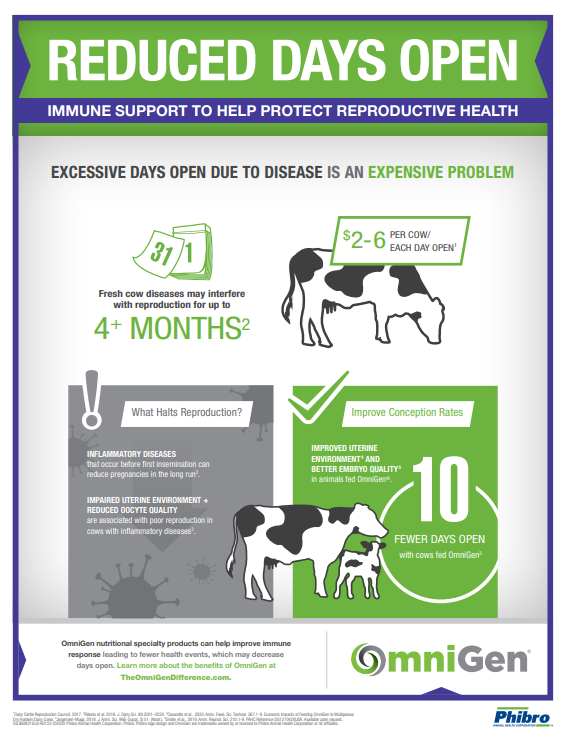Help Optimize Reproductive Performance and Reduce Days Open
Expert tips for managing the depth and duration of immunosuppression to help improve reproduction rates

With more than 30 years of experience as a veterinarian, Dr. Michael Hodgman has helped countless dairy producers assess the reproductive health and performance of their herds. He says that “days open” — the period between parturition and following conception — is a metric that producers use to gauge reproductive performance. Dr. Hodgman encourages them to carefully consider their transition cow management practices to reduce days open and improve reproductive rates.
“When considering transition time, I look at the period of dry-off through 30 days post fresh and recommend producers consider several interventions that are key to managing a cow’s energy balance and her immune function and status,” says Dr. Hodgman, Senior Technical Services Manager, Phibro Animal Health Corporation. “It’s more difficult for cows that had postpartum disease to conceive — so when it comes to optimizing a herd’s reproduction performance, it’s about successfully managing the depth and duration of both negative energy balance and immunosuppression during this time.”
Five Ways to Help Improve Reproduction and Reduce Days Open
- Review and adjust management practices.
Dr. Hodgman advises producers to consider several management practices for their transition cows. These suggestions include practices such as having dedicated dry off pens, separation of prefresh heifers from adult cows if possible, and carefully looking at fresh cow processing and handling. - Make necessary dietary adjustments.
There are several feed supplements and dietary adjustments available that may help producers improve the reproductive performance of their herd. Dr. Hodgman recommends feeding OmniGen® nutritional specialty products, which are proven to improve immunity. Improved immunity may help reduce days open in dairy cows. He also suggests feeding Animate® nutritional specialty product beginning at 21 days prior to calving to optimize calcium metabolism and including feed additives that maximize energy from the feed during this crucial period. - Help prevent and control mastitis.
Mastitis can negatively affect a cow’s ability to conceive, so it’s imperative to bolster the immune system to help prevent and manage this common, costly disease in both incoming heifers and adult cows. “Evaluate herd records looking at both fresh cow clinical mastitis and first test somatic cell count and review the dry off process and procedure. Then discuss, if needed, adjustments with your management team.” - Vaccinate your cows (and calves) appropriate to the herd’s needs.
With your veterinarian, develop a program to vaccinate both your dairy cows and replacement heifers for respiratory and intestinal diseases, Lepto and other diseases that are common to the farm. - Implement a monitoring program.
Dr. Hodgman encourages producers to measure dry matter intake and urine pH and to score body condition before freshening. Milk weights, ketosis monitoring and body condition scoring post fresh as well as other data also provide useful insights when assessing how cows transition from dry to lactating.
“Cows that transition without health challenges become pregnant again much more easily than those that don’t experience a smooth transition,” says Dr. Hodgman. “For this reason and many others, producers strive to have healthy, high-performing, problem-free cows. As a member of the Phibro team, I’m here to give producers the tools they need to help optimize and measure reproductive health and performance.”
To learn more about how to help improve the reproductive health of your dairy herd, visit TheOmniGenDifference.com or contact your local Phibro representative.
OG390722GLB ©2022 Phibro Animal Health Corporation. Phibro, Phibro logo design, OmniGen, and Healthy Animals. Healthy Food. Healthy are trademarks owned by or licenses to Phibro Animal Health Corporation or its affiliates.











 OmniGen Green is Organic Material Review Institute (OMRI) listed.
OmniGen Green is Organic Material Review Institute (OMRI) listed.